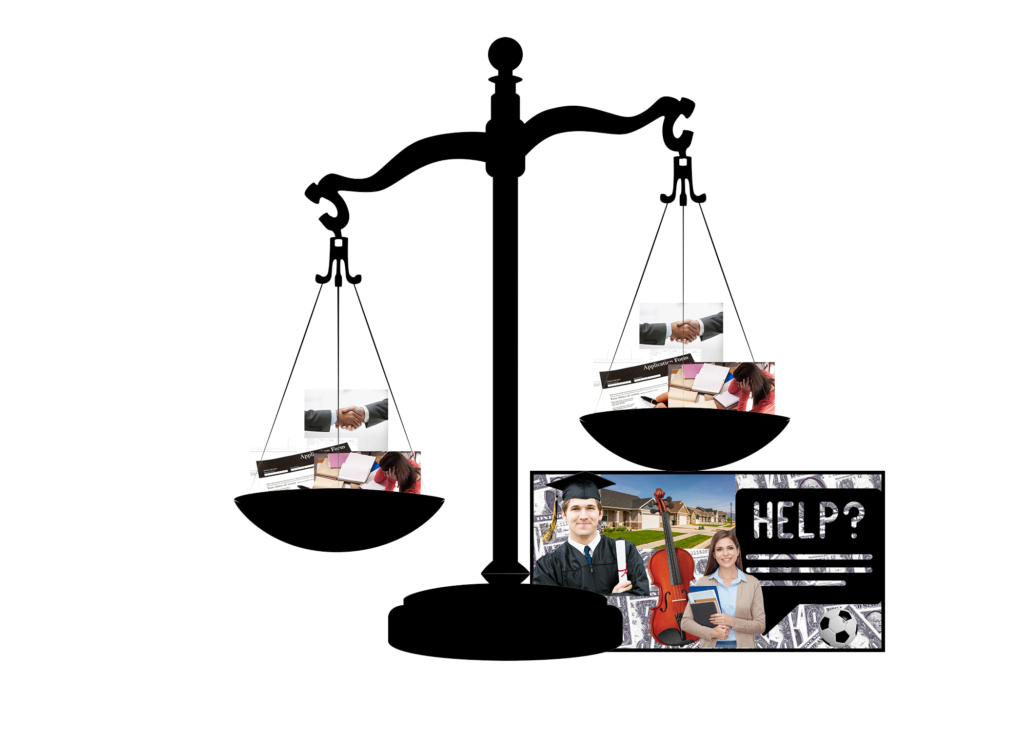
The Problem with Education
Education is unbalanced: its results are powerfully shaped by the various advantages conferred by social class. The gap between high income and low income children in terms of SAT scores is fifty percent larger in the 21st century than it was in the 1960s (Duncan and Murnane 2014:3). The fact that such a gap exists is an affront to the idea of public education being an equalizer, and the fact that it’s only getting worse is troubling. There are many causes behind these class-based imbalances.
The Advantages of Wealth
Money can grant large educational advantages to those who have a lot of it. It’s no secret that a significant portion of American public school funding comes from property taxes (Skinner and Riddle 2019;4). Given that wealthier people pay more in property taxes, the public schools in their areas receive more funding. Schools in high income neighborhoods simply have more to work with, and thus have an advantage over low-income schools in terms of supplies, teacher salaries, facilities, much else (Duncan and Murnane 2014;6).
Class and Child-Rearing
A key part of class based educational inequality is rooted in class differences in parenting. Concerted cultivation, employed by the middle class, aims to deliberately shape a child with the skills needed to be successful in a middle class environment (Lareau 2003:5). Middle class parents help their kids develop cultural capital, more specifically the social skills and prestige needed to operate in such an environment. Meanwhile, accomplishment of natural growth, the parenting strategy most used by lower class parents, gives opportunity for a child to grow, but does not deliberately guide a child through development for late professional success (Lareau 2003:5).
These differential methods of child-rearing make a massive difference in children’s development, and particularly in how they interact with authority figures. A child that is raised through concerted cultivation is more likely to be open and confident, asking questions and developing self-advocacy with doctors, teachers, and other professionals (Lareau 2003:126). The same principle applies within the classroom: working-class children are less proactive in terms of asking for help (Calarco 2011:869). This tendency is alarming, as self-advocacy is one of the most important skills to have as a student, and later, as a professional.
Are These Really Different Issues?
Wealth and parenting choices’ impacts on education can be closely intertwined. A key part of concerted cultivation is going above and beyond in terms of raising a child. Middle class parents help their kids join sports teams, take music lessons, and do whatever else it takes to maximize the potential for their children to succeed in a professional occupation. However, working class families do not have access to these same resources, such as the time or money for many enriching extracurricular activities (Lareau 2003:248). Additionally, both due to a lack of time and class entitlement, working-class parents are less likely to talk to the schools directly about their children’s education (Calarco 2014:1023). This shows that the lower class is restricted in its ability to interact with authority, not only in terms of a lack of opportunity, but also in the terms of the cultural capital needed to navigate the interaction (Lareau 2003:31). When looking at the “separate” issues like this, it becomes clear that class as a whole, not any individual culprit, is responsible for these educational inequalities.
Perhaps the best example of the ways class manifests itself in education is the transition to higher education. There’s the obvious: college is expensive, and many students simply can’t afford to go. Beyond that, though, the application process is a great example of how important a relationship with an institution is. For example, middle and upper class students often draw on outside tutors to help with the process, writing personal essays, and preparing for SATs (McDonough 1994:428). Additionally, the cultural capital that parents hold comes in handy, allowing students to consult and plan with the aid of their parents (Cabrera and La Nasa 2001:124). These considerable resources give an advantage in college applications for upper and middle class families, as they help students achieve the standards that colleges want in applicants (Stevens 2007:15). College applications serve as a prime case for class exerting itself in the educational process.
There is no greater boost in education than to have been born in the right circumstances. The rise of concerted cultivation among middle and upper class parents in addition to existing wealth barriers, makes the act of just trying to learn, and by extension, succeed in society, much harder than it needs to be for lower class children.
References
Duncan, Greg J., & Robert J. Murnane 2014 “Growing income inequality threatens American education.” Phi Delta Kappan, 95(6). Retrieved March 15, 2023 (https://journals.sagepub.com/doi/pdf/10.1177/003172171409500603).
Skinner, Rebecca R., and Wayne Riddle. “State and Local Financing of Public Schools. CRS Report R45827, Version 2.” Congressional Research Service (2019). Retrieved March 15, 2023 (https://files.eric.ed.gov/fulltext/ED597879.pdf).
Calarco, Jessica McCrowry. 2011 ““I Need Help!” Social Class and Children’s Help-Seeking in Elementary School.” American Sociological Review 76(6). Retrieved April 6, 2023 (https://journals.sagepub.com/doi/pdf/10.1177/0003122411427177).
Calarco, Jessica McCrowry. 2014 “Coached for the Classroom: Parents’ Cultural Transmission and Children’s Reproduction of Educational Inequalities.” American Sociological Review 79(5). Retrieved March 3, 2023 (https://journals.sagepub.com/doi/pdf/10.1177/0003122414546931).
Lareau, Annette. 2003. Unequal Childhoods: Class Race, and Family Life. Berkeley and Los Angeles, California, London, England: University of California Press.
Stevens, Mitchell L. 2007. Creating a Class: College Admissions and the Education of Elites. Cambridge, Massachusetts, London, England: Harvard University Press.
Cabrera, Alberto F., and Steven M La Nasa. 2001. “On the path to college: Three critical tasks facing America’s disadvantaged.” Research in Higher Education 42(2): Retrieved May 3, 2023(https://www.jstor.org/stable/pdf/40196425.pdf).McDonough, Patricia M. 1994. “Buying and Selling Higher Education: The Social Construction of the College Applicant.” The Journal of Higher Education 65(4): Retrieved May 3, 2023 (https://www.jstor.org/stable/pdf/2943854.pdf).